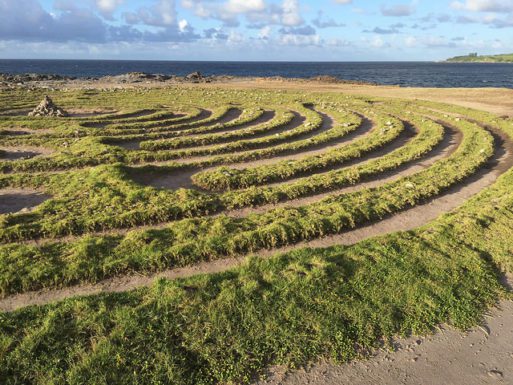
Dragon’s Teeth Labyrinth in Kapalua, Maui, Hawaii
The first time Rob Meyer-Kukan ever walked a labyrinth, it was at the suggestion of a friend who knew he had been struggling. Meyer-Kukan was dealing with a different kind of loss and grief. He was mourning the death of a long-term relationship. His friend told him about a labyrinth at their local church. Meyer-Kukan had no idea what to expect, but he walked with an open mind and the practice helped him heal.
Rob’s experience was not unique, and because he understood the power of labyrinth walking first hand, he became a labyrinth facilitator so that he could help others experience the release and insight he received. He now serves as the virtual events coordinator for the Labyrinth Society.
Experts on grief explain that walking a labyrinth can be a healing experience when grieving the loss of a loved one. Labyrinths invite walkers to enter at one point and follow the path to the center. There is no mystery as to which way to walk. Trusting the path to take you where you need to go is part of the labyrinth walk experience.
How Labyrinths Heal
“You go to a maze to get lost. You go to a labyrinth to find yourself.”
With grief can come a torrent of emotions, most often in waves that ebb and flow with time. There are many strategies to work through these feelings, such as yoga, meditation or exercise. Walking labyrinths can be another great way to process emotions during difficult times. In addition to all the physical and mental benefits to walking, by walking purposefully in a labyrinth, you can also reduce stress, quiet your mind and open your heart.
Yadina Clark, vice president of communications at the Labyrinth Society, asserts the distinction between labyrinths and mazes: “You go to a maze to get lost. You go to a labyrinth to find yourself.” Labyrinths give you the opportunity to walk on one circuitous path to the center. With no possible wrong turns or dead ends, you can relax, knowing that you will reach the heart of the labyrinth if you just keep going. While on the path, you can release all of the tension of the day, letting the pattern take you where you need to go.
“It helps to have a grounding moment,” Clark suggests. “You should focus before entering a labyrinth. You can’t just walk from ordinary space to sacred space without acknowledging it.” Clark tells walkers that they are crossing a threshold from the everyday into something special, a set aside place, when they enter a labyrinth.
Labyrinths can be so effective with processing grief because “they serve as a container,” Clark explains. “Whether or not you call labyrinths sacred, they give you the time and space to observe your feelings. It gives you permission to examine those feelings. This may be cathartic, meaningful, and comforting.”
When Meyer-Kukan’s mother died in 2018 from complications after open-heart surgery, he already had a practice of bringing his life to the labyrinth. “Sometimes I would go to the labyrinth with an intention in mind. Today, I’m going to work through this aspect of my grief or these feelings about my mother. Other days, I would have nothing on my mind and not know why I was going, but I went anyway.” He shares that he always exited the labyrinth believing it to be a “safe space to open your heart, release and receive.”
Types of Labyrinths
There are many types of labyrinths to explore. Permanent labyrinths can usually be found outside. They can be made of earth, tracks in a field, or outlined with grass. Others are composed of rocks that signal the path the walker should follow. The labyrinth pattern may be painted on concrete or even a boardwalk. These labyrinths afford the walker the opportunity to interact with nature, which can be an added benefit and help with grief.
Portable labyrinths have become very popular. These paths are typically made of canvas and provide a labyrinth experience for indoor gatherings. Portable labyrinths are often found inside churches and fellowship halls. They can be purchased for occasional use or rented as part of an event. Many businesses use these labyrinths as part of retreat activities.
Our Top Recommended Labyrinths to Comfort and Heal
With so many incredible labyrinths in the U.S. to choose from, it’s hard to recommend just a few. Nevertheless, we compiled this list as a starting place. We hope you find one that appeals to you.
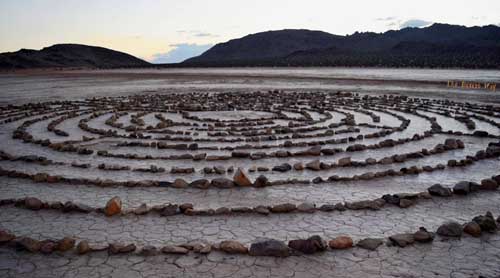
1. Fairview Dry Lake Labyrinth
Located in Apple Valley, California, this 62-foot labyrinth offers the ultimate quiet time. It’s been called the “labyrinth in the middle of nowhere,” and for good reason. Though it’s immensely popular, walkers barely see others when they visit since the labyrinth is so far off the beaten track. The best way to find it is to use the GPS coordinates: 34°33’59.9″n 117°05’31.0w.
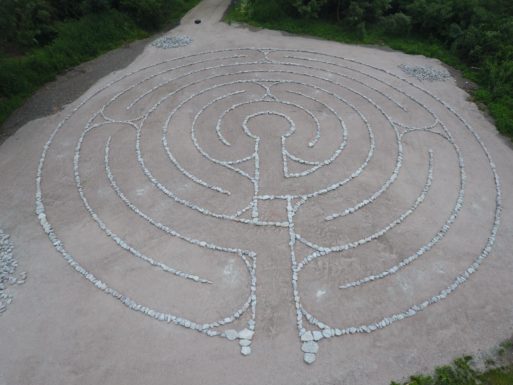
2. Branford Labyrinth on the Greenway Trail
This stone path is located on the Greenway Trail in Branford, Connecticut. You can reach this labyrinth by following the Tabor Trail section of the Shoreline Greenway Trail. Locals often hold candlelight walks, and you can find more events at this labyrinth on their Facebook page. Visit Branford Labyrinth at 48 Tabor Dr., Branford, CT.
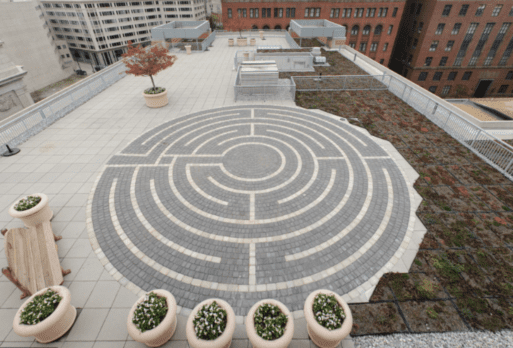
3. Rooftop Labyrinth at the American Psychological Association
Located on the roof of the American Psychological Association in Washington, D.C., this labyrinth features beautifully designed pavers overlooking the city. This walk gives APA employees and visitors a place of reflection in the middle of downtown. You can visit this labyrinth at the APA: 750 First St. NE, Washington, DC.
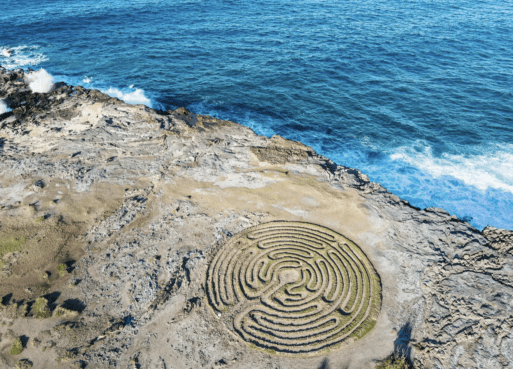
4. Dragon’s Teeth Labyrinth
This oceanside labyrinth is comprised of stone on a bit of grass. Visitors to the island of Maui can visit Kapalua and take in the beautiful view of the Pacific Ocean while walking to the center of the labyrinth. There is a small car park at the end of Lower Honoapiilani Road, where you will find the start of the dragon tooth trail. You will find the Dragon’s Teeth – also called Makaluapuna Point – on the northwest coast of Maui, just past Kapalua.
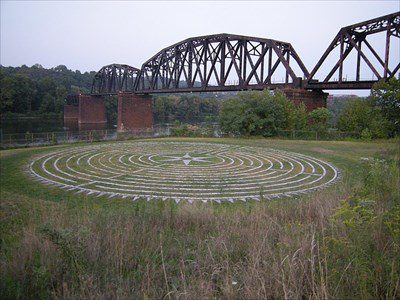
5. Homestead Labyrinth
Lying adjacent to the community’s historic Pump House near the sprawling Waterfront shopping complex, the Homestead Labyrinth in Homestead, Pennsylvania is 68-foot journey inward. Lorraine Vullo, the installer of this labyrinth, has dedicated it to those who died at Homestead Strike, the most prominent labor conflict in U.S. History. Visit this memorial at 54 E Waterfront Dr., Homestead, PA.
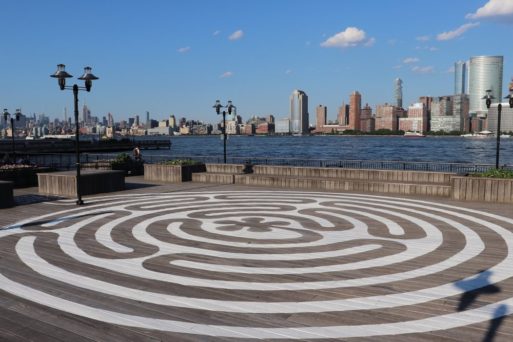
6. Labyrinth [No. 9]
Located in Jersey City, Labyrinth [No. 9] created by Katelyn Halpern, was created for “Reflection and the Generation of Love.” Visitors of J. Owen Grundy Park can journey to the center on the boardwalk, enjoying a space that was made for love and open hearts. Enjoy the seaside view just outside Exchange Place on Hudson St. in Jersey City, NJ.
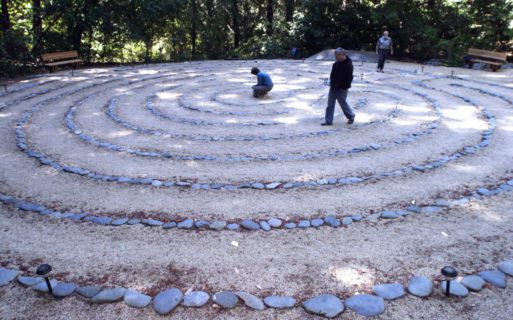
PHOTO BY LEN VAUGHN-LAHMAN
7. Quaker Center Labyrinth
This labyrinth is at the heart of the Quaker Center in Ben Lomond, California. Located in the heart of the Santa Cruz mountains, the labyrinth is about 50 feet in diameter and has seven walking cycles. The tranquil path is lined with smooth river rocks and is available to all Quaker Center users. The general public is asked to call the Quaker Center office at 1 (831) 336-8333 to make sure the labyrinth is available. Find the Quaker Center at 1000 Hubbard Gulch Rd., Ben Lomond, CA.
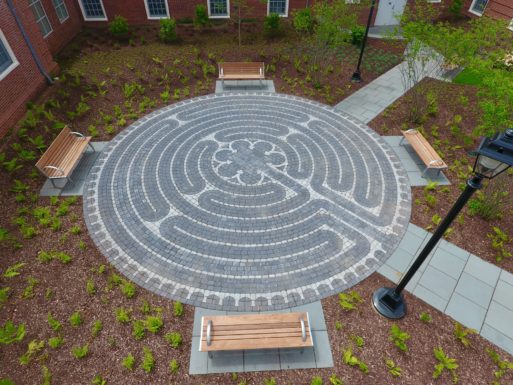
8. Yale Divinity School Labyrinth
Featured in Bill Ludwig’s book, “Chasing Labyrinths,” this labyrinth is located at the ivy league university’s campus in New Haven, Connecticut. You don’t have to be enrolled at Yale to take advantage of the serene walk on decorative pavers. Take a trip to New England and visit this labyrinth at 409 Prospect S., New Haven, CT.
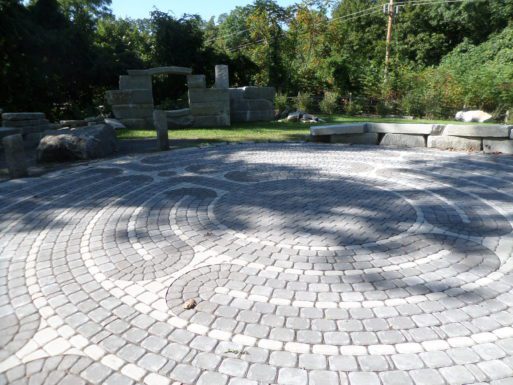
9. The Park at Bellows Falls Historical Society
Situated on eight acres adjacent to the Grist Mill Museum, in Bellow Falls, Vermont, the park features trails and other activities for nature lovers. The labyrinth overlooks the Connecticut River at the Hawk’s Eye View Overlook. Visit the historical society at 20 Mill St., Bellows Falls, VT.
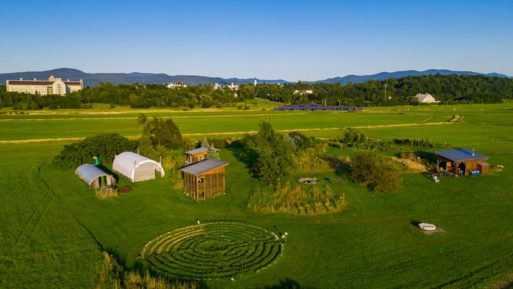
10. Labyrinth at the Knoll
Located on the Middlebury College campus in Cornwall, Vermont, The Knoll is a place that seeks to cultivate well-being in people, places, and the planet. The labyrinth was created by renowned labyrinth builder, Lars Howlett and built by volunteers to celebrate 15 years at The Knoll. Mindful walkers can enjoy the serene farmland while contemplating important questions. Visit The Knoll at 152 Vermont Rte. 125, Cornwall, VT.

11. Lavender Labyrinth
Cherry Point Farm and Market in Shelby, Michigan, features one of the longest and most visually appealing labyrinths on our list. Earth mounds and lavender plants mark the path that spirals around a stone center. Cherry Point invites visitors to walk the paths, absorb the essences, and experience the serenity of this unique garden. Experience this breathtaking labyrinth at 9600 W. Buchanan Rd., Shelby, MI.
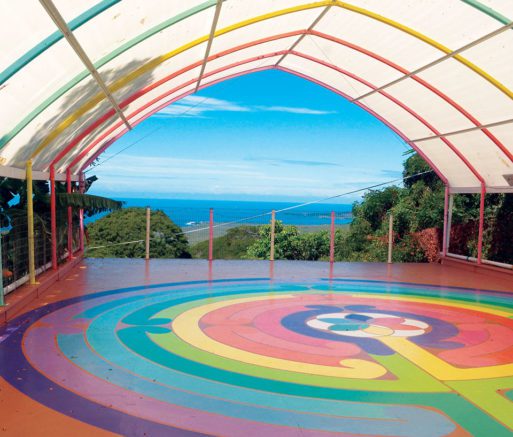
12. Dragonfly Ranch Labyrinth
This colorful open-air labyrinth can be found at the Dragonfly Ranch on the island of Kauai in Hawaii. Though it’s part of a bed and breakfast, the public can contact the B&B to schedule a walk in the labyrinth. Find the ranch at 4-5146 Keala O Keawe Rd., Captain Cook, HI.
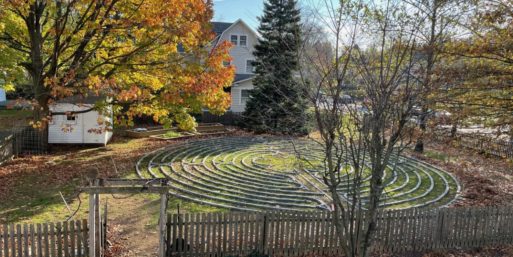
13. Bloomfield Presbyterian Church on the Green
The Bloomsfield Presbyterian Church in Bloomfield, New Jersey, was built in the early 1800s and features turn of the century architecture and historic stained glass windows. As part of a mindfulness initiative, the campus features a stone and grass labyrinth. You can visit the labyrinth at any time at 147 Broad St., Bloomfield, NJ.

14. Merciful Love Labyrinth
Constructed in 2001, this lovely labyrinth was made by volunteers who carried stones by hand to build the path. This holy ground is part of the National Shrine of Saint Thérèse in Juneau, Alaska. Visitors can wonder at the majestic beauty of the peninsula and meditate at the sacred spot. Visit the shrine and labyrinth at 1425 Glacier Highway, Juneau, AK.
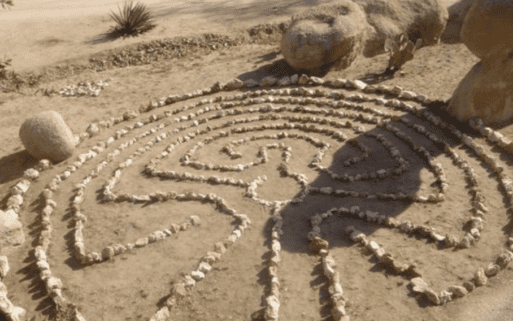
15. Triangle T Historic Ranch
Surrounded by rocks and cacti, the labyrinth at Triangle T in Dragoon, Arizona, offers a desert path to self-reflection. Though the labyrinth is part of a ranch, it is open to the public. You can walk the path at 4190 Dragoon Rd., Dragoon, AZ.
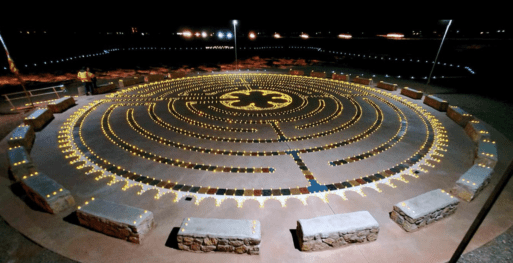
16. Trinity Turtle Healing Labyrinth
The Trinity Turtle Healing Labyrinth in Alamogordo, New Mexico, is modeled after two French cathedrals, the Reims Cathedral and the path on the head of the turtle after the Labyrinth of Chartres. This labyrinth is available to the public 24/7 and can be found at 7440 US Hwy 54/70 Alamogordo, NM.
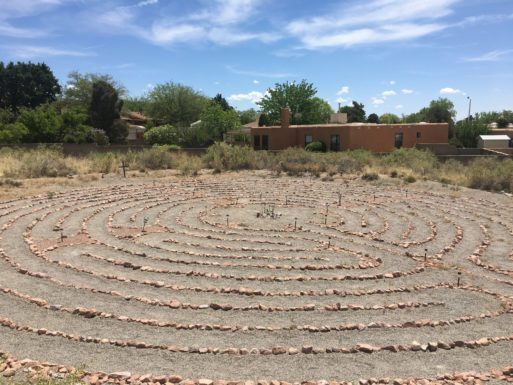
17. New Life Presbyterian Church Labyrinth
Visitors are encouraged to view this eleven-circuit labyrinth in Albuquerque, New Mexico, as the end of a pilgrimage or journey. Walkers considers the labyrinth a tool that encourages internal and relational harmony and helps satisfy the “spiritual hunger” present in our world. Visit this stone labyrinth at 5540 Eubank Blvd. NE. Albuquerque, NM.
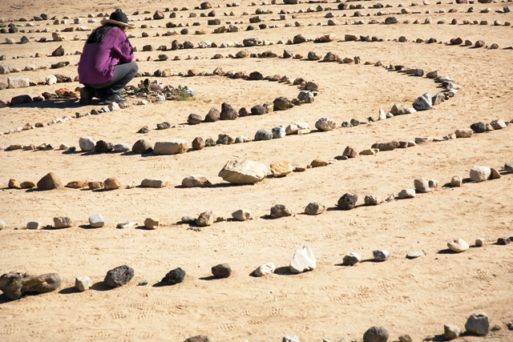
18. The Rose Labyrinth at Joshua Tree
This simple rock-studded labyrinth can be found at the famous Joshua Tree Retreat Center in California. Visitors are encouraged to meditate while walking and interacting with the desert. Walk this seven-circuit path at 59700 Twentynine Palms Highway, Joshua Tree, CA.
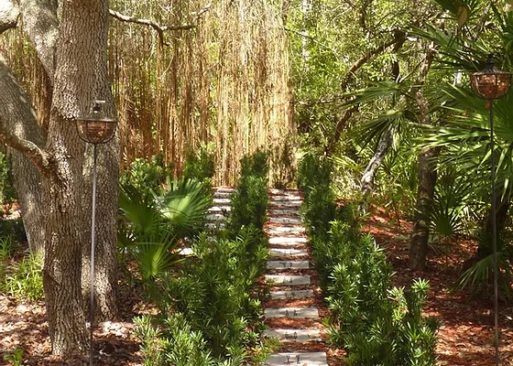
19. 256 Odu Labyrinth
This tropical labyrinth is part of the Ola Olu Retreat in Crescent City, Florida. Florida residents and visitors can walk the path in-person. The retreat also offers virtual walks of the labyrinth here. When in Florida, see this gorgeous stone path at 222 Clear Lake Rd., Crescent City, FL.
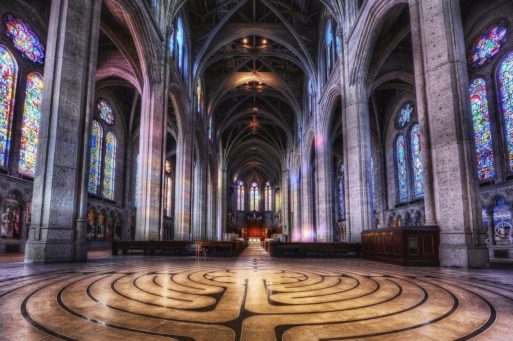
20. Grace Cathedral Labyrinth
Grace Cathedral in San Francisco actually houses two labyrinths and is considered the home of the Modern Labyrinth Movement. The indoor labyrinth can be walked during the cathedral’s open hours; the cathedral also holds monthly candlelight labyrinth walks.
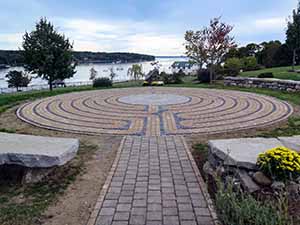
21. Phineas Parkhurst Quimby Labyrinth
This labyrinth in Belfast, Maine, is a 30-foot diameter, ADA-accessible paved labyrinth on Belfast Common, the park overlooking Belfast Harbor and Penobscot Bay. Dedicated to Quimby, who is considered the “Father of the New Thought Movement,” this paved path was created in 2016 and is the first parcel of community-owned land in Maine. Visit this labyrinth at Belfast Commons, Union St. Belfast, ME.
Final Thoughts Before Your Walk
As you can see from these examples, labyrinths are the perfect place to process grief. Because there’s no wrong way to walk a labyrinth, it is highly adaptable to every person, their needs and where they are on their grief journey. You can walk it alone, with a friend or with your community. The meditative journey inward can be aligned with any faith or religion. The walk is not limited by anyone’s personal experience, and there is no prescriptive way to walk. People may pause at any time in the labyrinth, or even travel it on their knees if that’s what they have in their heart to do. It’s your journey to the center, your walk inward, so you can go at your own pace.

 21 of the Most Amazing Labyrinth Walks for Healing in the US
21 of the Most Amazing Labyrinth Walks for Healing in the US


 “Help Me, Helen”
“Help Me, Helen”

 “As Tears Go By” by Marianne Faithfull
“As Tears Go By” by Marianne Faithfull














